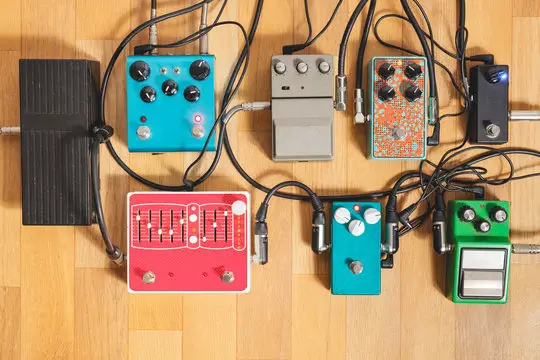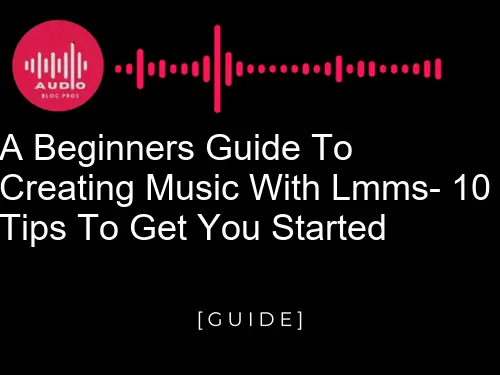If you’re looking to explore the endless possibilities of creating music with LMMS, then you have chosen the digital audio workstation for you. LMMS (formerly known as Linux MultiMedia Studio) is a free, open-source software that runs on Windows, macOS, and Linux.
Whether you’re a beginner or a seasoned producer, LMMS provides users with a wide range of tools and features that can help create the perfect song. To get started with LMMS, here are some tips that will help you on your way.
Stats and Info:
• LMMS is a free and open-source digital audio workstation.
• It is available for macOS, Windows and Linux.
• It provides virtual instruments, effects, sound generators, and other tools for music creation.
• It is capable of producing a wide range of music genres.
• It is available in multiple languages.
• It supports a variety of audio formats, including WAV and Ogg.
• It has an intuitive and user-friendly interface.
• Its plugin system allows users to extend the capabilities of LMMS.
• It supports VST, LADSPA and LV2 plugins.
• It has been around since 2004.

Our Personal Top 10 Tips for Getting Started with LMMS:
1. Be sure to have the latest version of LMMS installed.
2. Familiarize yourself with the audio project settings, such as sample rate and bit depth.
3. Experiment with the various instruments and effects available.
4. Explore the various audio production and mixing tools available.
5. Utilize the plugin system to expand the capabilities of LMMS.
6. Look into third-party resources such as tutorials and video guides.
7. Make use of the preset projects that come with LMMS.
8. Practice by creating simple projects and compositions.
9. Don’t be afraid to experiment and explore new possibilities.
10. Don’t be afraid to ask for help from other LMMS users or the helpful community.
One of the biggest pain points associated with getting started with LMMS is the steep learning curve. While the program is powerful and versatile, it does take some time and effort to get comfortable with all the different aspects of the software.
Additionally, we find that the user interface can be a bit confusing at first, and some may find that the on-screen navigation isn’t intuitive. To solve these issues, it is best to start by familiarizing yourself with the LMMS user manual and watching some tutorials, which can help you get a better understanding of the features.
Additionally, I find that there are plenty of helpful forums and resources online where you can ask questions, search for assistance, and get tips and advice from other users. Finally, be sure to take advantage of all of the available plugins, samples and effects that come pre-loaded with LMMS, so you can make the most of your production workflow.
Extra Tips
Learning to use LMMS for music production can seem daunting for beginners. However, with the right guidance and resources, you can quickly become an expert in this powerful software.
First and foremost, ensure you have the latest version of LMMS installed on your computer. This is important as the latest version contains many new features and improvements that will make it easier to use.
Get familiar with the software’s layout and menus. Take the time to go through each of the various windows and tabs and become familiar with the different tools and options available.
Make sure you have all the necessary hardware and plugins to make music. This includes sound cards, audio interfaces, controllers, and VST (Virtual Studio Technology) plugins. Having the right setup will make your music production process much smoother.
By following these tips, you can ensure that you are ready to start working on your music production projects with LMMS. Additionally, there are many more tips available online that can help you get started and become more proficient in using the software. With a little practice and dedication, you can quickly become an LMMS expert and make some amazing music!
Making Music with LMMS
Getting your music career off the ground can be a daunting process, but with LMMS, you can jumpstart your professional music-making journey with ease. LMMS is a free and open-source music production suite that enables you to create sounds and compose your music straight from your computer.
Many aspiring music producers have heard about LMMS as a great DAW to get started with music production. But where do you start when you’re just getting your feet wet in the industry? With these ten tips, you’ll be off to a good start creating your own tunes in no time! With a little knowledge and practice, you can create professional-sounding music using LMMS and join the ranks of the top music producers in the game.
Are you ready to take your beat-making skills with LMMS to the next level? With a few tweaks to your workflow and some creativity, you can turn your beats from good to great. From leveraging plugin effects to working with MIDI controllers, you can use the power of LMMS to craft professional-sounding beats that will make your music stand out. Learn how to make the most of your LMMS software and unleash your creative potential.
Rounding Up
Master the Interface: A Solid Foundation for LMMS Success. It’s essential to understand how the LMMS interface works before diving into projects. Spend some time getting to know the layout of the Metronome, Beat+Bassline Editor, and Piano Roll. Before long, the interface will feel comfortable, and you’ll be able to work quickly and efficiently.
As a long-time user of the free, open-source Digital Audio Workstation called LMMS, I have learned a few tips and tricks that have made my experience with the platform much easier. From file management to sound design, I have found these tips for getting started with LMMS to be invaluable:
First, create a project folder for each individual song you create and store all the relevant files (samples, presets, etc.) within the project folder. This way, you’ll always know where to access them, and it will be easier to find old projects. Second, learn the keyboard shortcuts so that you can work quickly and efficiently without clicking through menus.
This will save you a lot of time and hassle! Third, take the time to experiment with different sound and mixing techniques to get the most out of your audio. You’ll find that the options are almost limitless, and you can create some amazing sounds just by playing around.
Fourth, understand the basic concepts behind the sound design and mixing before you start working with LMMS. You’ll find it easier to understand the environment and use all the features LMMS has to offer. Fifth, try to limit the number of tracks and plugins you are using in your project.
This will help to keep your system running smoothly and save you valuable time. Sixth, take advantage of the various tutorials and help documents available online to understand the various features of LMMS. By doing so, you’ll be able to use the software to its full potential.
Finally, take the time to explore the various options LMMS has to offer. Don’t be afraid to experiment and push the boundaries of your creativity. With the right approach, you’ll quickly find yourself enjoying the experience of using LMMS. With the help of these tips, I hope you’ll be able to get started with LMMS and make some amazing music!
What is LMMS?
LMMS (formerly known as Linux MultiMedia Studio) is a free, open-source digital audio workstation and music production software available for Windows, Mac OS X, and Linux. LMMS allows users to produce music from their computers using synthesizers, samplers, and virtual instruments.
How do I install LMMS?
Installing LMMS is easy. For Windows and Mac users, you can download and install the software from the official LMMS website. For Linux users, you can install it via the command line or your package manager (e.g. apt-get).
What types of audio files can I use in LMMS?
LMMS supports many audio file formats, including WAV, AIFF, MP3, FLAC, Ogg Vorbis, and more. You can also import MIDI files and samples directly into LMMS.
What type of hardware do I need to use LMMS?
You don’t need a lot of hardware to use LMMS. All you need is a computer with at least 2 GB of RAM and a decent processor. If you want to use a MIDI controller or audio interface, you may need to purchase additional hardware.
How do I get started with LMMS?
A great way to get started with LMMS is to take a look at the tutorials and walkthroughs available on the official website. You can also find lots of helpful information in the online resources section of the official website. Additionally, there are many helpful YouTube tutorials available for LMMS.

